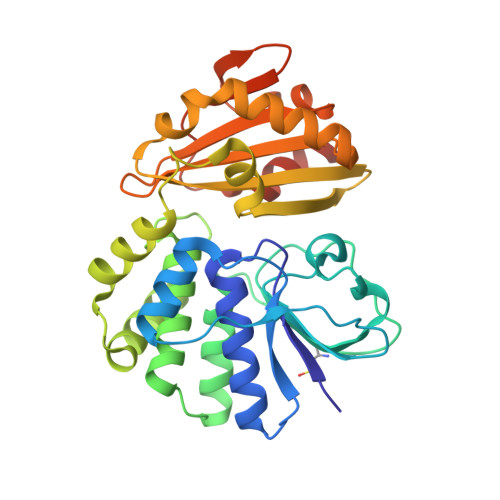Structure of inorganic pyrophosphatase from Staphylococcus aureus reveals conformational flexibility of the active site.
Gajadeera, C.S., Zhang, X., Wei, Y., Tsodikov, O.V.(2015) J Struct Biol 189: 81-86
- PubMed: 25576794
- DOI: https://doi.org/10.1016/j.jsb.2014.12.003
- Primary Citation of Related Structures:
4RPA - PubMed Abstract:
Cytoplasmic inorganic pyrophosphatase (PPiase) is an enzyme essential for survival of organisms, from bacteria to human. PPiases are divided into two structurally distinct families: family I PPiases are Mg(2+)-dependent and present in most archaea, eukaryotes and prokaryotes, whereas the relatively less understood family II PPiases are Mn(2+)-dependent and present only in some archaea, bacteria and primitive eukaryotes. Staphylococcus aureus (SA), a dangerous pathogen and a frequent cause of hospital infections, contains a family II PPiase (PpaC), which is an attractive potential target for development of novel antibacterial agents. We determined a crystal structure of SA PpaC in complex with catalytic Mn(2+) at 2.1Å resolution. The active site contains two catalytic Mn(2+) binding sites, each half-occupied, reconciling the previously observed 1:1 Mn(2+):enzyme stoichiometry with the presence of two divalent metal ion sites in the apo-enzyme. Unexpectedly, despite the absence of the substrate or products in the active site, the two domains of SA PpaC form a closed active site, a conformation observed in structures of other family II PPiases only in complex with substrate or product mimics. A region spanning residues 295-298, which contains a conserved substrate binding RKK motif, is flipped out of the active site, an unprecedented conformation for a PPiase. Because the mutant of Arg295 to an alanine is devoid of activity, this loop likely undergoes an induced-fit conformational change upon substrate binding and product dissociation. This closed conformation of SA PPiase may serve as an attractive target for rational design of inhibitors of this enzyme.
- Department of Pharmaceutical Sciences, University of Kentucky, College of Pharmacy, 789 S. Limestone St., Lexington, KY 40536, United States.
Organizational Affiliation:



















